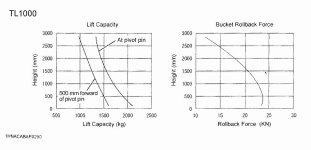Re: Mahendra 1526 Vs Kubota L2501
QUOTING & COMMENTS RE: s219]One of the points in my story is that when I went to look at brand "B" I was interested in a smaller model, and the sales guy instead recommended a slightly larger model with better specs and all of the same advantages I came to appreciate about brand "B". And it ended up costing me less than I was expecting, because the street prices where about 15% less than the website MSRP had suggested. I would have never expected that based on my original "paper" study of specs. That was one of the key benefits of shopping around and you can't get that without visiting all the dealers, talking to the people there, and driving machines. I will say this, it's highly dependent on finding a good dealer and good sales guy, but again that's part of the shopping process that should factor in.
One of the things about the
L2501 that just can't be appreciated without a test drive is that it's more like the old
L3800 in disguise, spec'd down to avoid Tier IV Final. I had suspected it was a sleeper for a while, and when at a Kubota dealership a few weeks back looking at Grand L models, I asked the salesman about it. He confirmed that, said they sold a ton of them, and got me the keys for a test drive. It had a lot more guts than my
L3200 (which is otherwise the same exact tractor but with a smaller engine that makes power at higher RPM), and that was obvious just driving around. So if I had been comparing the specs of an
L2501 with competing makes, and taken a test drive, I'd be honing in on the fact that it has a much larger engine in this class (20 cu.in bigger than the 1526) rated at lower RPM, and it weighs a bit more. In the world of tractors, power and weight are specs that many consider to trump all else. It's a case where the paper specs sort of unite with the test drive experience to make you realize there's a "special brew" on the
L2501.
I found that my old
B7200 had more Grunt Torque at low RPM comparatively to my new Max28, considering the HP disadvantage of the
B7200. Agree mike69440
The last thing I will mention is to be cautious about specs that appear to be extra good on some of the makes. For example, my neighbor's tractor can theoretically lift as much as my
L3200 on paper, but when you do that with both machines, it's a white knuckles experience on his compared to a yawn on the L. The difference comes down to the combination of the tractor size/weight, the construction of the loader frame and arms, and the control you get through the valve lever. On paper one would think my L was lame compared to this other tractor but real world experience shows exactly the opposite.
Give your neighbors poor little Max28 a break. When I size my neighbors
L3901, to my Max28 and
L39, the
L3901 (same frame as the
L2501) is closer to the
L39 than the max footprint wise. The Max is just a scrapy little runt. (mike69440)
Try fitting your L into a small horse barn to move a 1,000 lb pallet of feed. (mike69440)
Kubota's loader numbers are at generally given at max height -- which really means it's the minimum lift capacity of the loader. If you look at the lift curve given in the owner's manual for my LA524 loader (same as the LA525 on the
L2501), the actual lift capability down low is dramatically more. It's rated by Kubota for about 1150# at max height, but down low where you're going to be doing most of your work, it can lift 2750#. That's another example where paper specs need to be carefully compared to make sure it's apples to apples.
I would like to see the Loader curve for the
L3200. (mike69440)
I've used an
L3400 quite a bit, and the Loader was soft. I never checked the pressures. (mike69440)
I lift things up, I put things down, using relatively strong small frame tractors that would normally require a larger tractor. But lifting heavy things full height is just scary, and I do my best to avoid. (mike69440)
Loader lift height is very important in this case, since the loader on the
L2501 goes a full 10" higher (94") than the loader on the 1526 (84"). If I go by the Kubota curve in the owner's manual, it's rated around 1500# at an 84" height versus the 1560# spec of the Mahindra loader at that height. So now we're talking about maybe 60# advantage of the Mahindra based on that paper spec. If you had only gone by the 1150# rating of Kubota, you'd be missing that it is 10" higher, which explains a lot.
Good point. (mike69440)
Paper specs are great if you're comparing apples to apples and it doesn't matter how the tractors feel or drive, or how well they are built, or how well they age and hold their value. But it's not like that in the real world. What I most often see here on TBN is that someone comes here hot to buy, looking at specs and making spreadsheets, and then completely misses the point. There are a lot of brands and a lot of dealers, and it really pays to take your time and evaluate all the tractors carefully with a lot of consideration. If you are the type to give a lot of weight to paper specs, make sure you know what you're doing.
I think OP will be happy with the 1526, as it fits his size requirements and budget. (Mike69440)

